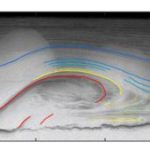The research of the ice sheet modelling group focuses on integrating observational data with dynamical models that describe how the ice flows in order to improve our representation of how the ice flows beneath the surface, and to reveal how the shape and flow of the Antarctic ice sheet has changed in the past.
These computational models calculate how the ice moves in response to gravity, which makes the ice spread and flow downhill. Other forces that resist this ice flow are produced by sliding, stretching and shearing of the ice and these are also included in the models. Observational data about the motion of the ice and its thickness are collected by satellites, aircraft and radar systems deployed by field parties on the Antarctic ice sheet. The ice sheet modelling group use a variety of mathematical techniques, especially inverse methods, to combine these measurements with ice sheet models.
Combining observational data with models of ice-sheet flow can help us to understand the links between ice sheets and climate by studying how the ice sheets behaved in the past when climate was different. Another application for these models is to work out whether marine ice sheets such as the West Antarctic Ice Sheet that rest on ground below sea level are stable to small changes, or unstable. If unstable, this could allow runaway retreat of this type of ice sheet. As well as helping to assess the stability of ice sheets past and present, the models also allow us to make forecasts of how the large ice sheets of Greenland and Antarctica could change in future and how much these changes might contribute to sea level.
- To develop new models representing all the processes responsible for changes to ice sheets.
- To study ice flow, grounding-line migration and their influence on the stability of ice sheets.
- To develop new ways that ice sheet models can be tested against observations.
- To combine models and measurements to achieve realistic, well calibrated models.
- To produce models explaining the past behaviour of ice sheets under different climates.
- To produce models capable of making projections of the future behaviour of ice sheets.
7 November, 2018
Fresh water freezing onto the bottom of the Greenland and Antarctic Ice Sheets leads to the formation of spectacular plume-shaped features, according to new research published today (7th November) in …
28 August, 2015
Most comprehensive ice loss model A new international study is the first to use a high-resolution, large-scale computer model to estimate how much ice the West Antarctic Ice Sheet could …


